
Highs and lows of pruning day
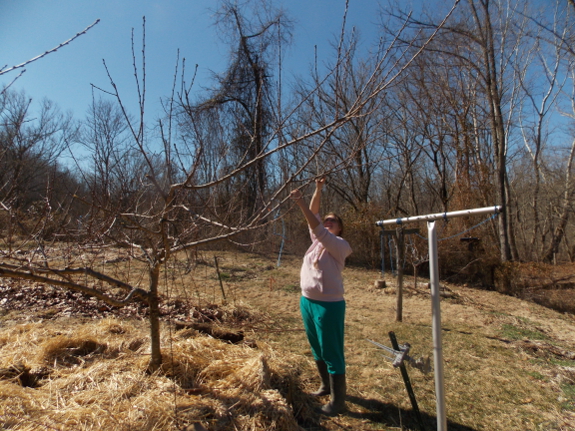
I saved our medium-sized
peach trees to train and prune when Kayla could get across the creek
since she had some of her own in need of attention. I could tell
she was a bit afraid of hurting the tree by doing it wrong, which made
me realize how far I've come in the last few years. It hasn't been
all that long since I pruned with book in hand and agonized over each
cut, but after a few years of pruning and seeing the results, I'm quite
comfortable pruning our peaches.
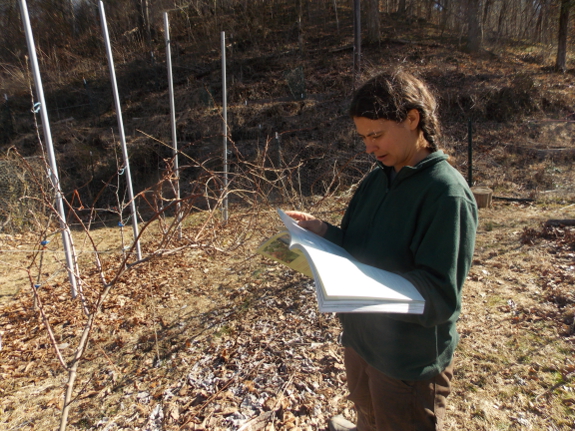
I haven't reached that
point with all of our fruit plants yet, though. I did a lot of
this --- reading over the relevant section in Lee Reich's The Pruning Book and Grow Fruit Naturally and then worrying over each cut. I was especially leery of harming our hardy kiwis since I'd sent some cuttings to a reader
a few weeks ago, and he reported that when they started leafing out, he
saw bloom buds! In other words, if I don't see flowers off the
hardy kiwis this year it's my own fault for cutting the bloom buds
off. Having Kayla present for moral support was very helpful in
this case, even though she knew less than I did --- it made me remember
that cutting usually works out alright.
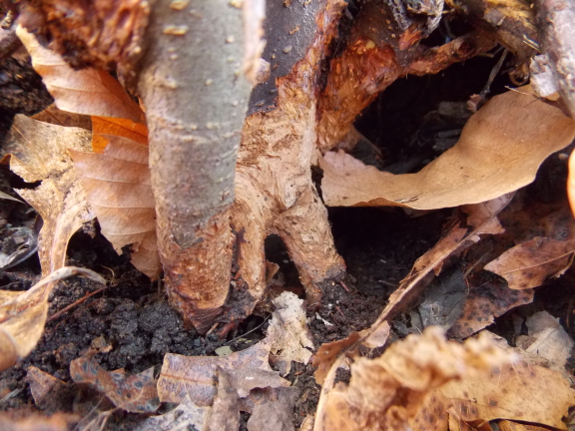
And then there's the huge
problem that I saw last week and have been trying to block out ever
since. All three of our just-ready-to-fruit apple trees in the
forest garden have been girdled just below the soil line and will
probably perish. (The Virginia Beauty, strangely 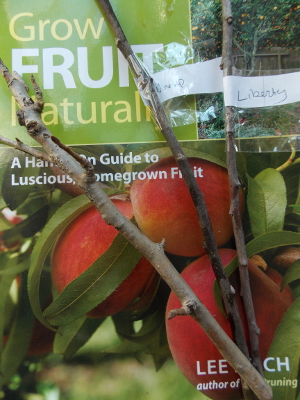 enough,
is fine, even though it's no more than fifty feet away.) I've
never protected the bases of our fruit trees because I'd never seen vole
damage, but I guess I'll have to cross that bridge now. And I'll
also need to consider whether growing sweet potatoes in the forest garden
was such a great idea --- it definitely produced an awesome living
mulch and lots of biomass, but I suspect the tasty tubers might be the
reason for the vole population explosion. Or maybe they just ate
my trees because of this winter's weird weather?
enough,
is fine, even though it's no more than fifty feet away.) I've
never protected the bases of our fruit trees because I'd never seen vole
damage, but I guess I'll have to cross that bridge now. And I'll
also need to consider whether growing sweet potatoes in the forest garden
was such a great idea --- it definitely produced an awesome living
mulch and lots of biomass, but I suspect the tasty tubers might be the
reason for the vole population explosion. Or maybe they just ate
my trees because of this winter's weird weather?
No matter what the cause
is, I don't want to lose the two apple varieties that aren't represented
elsewhere on our farm, so I took some scionwood and will graft them
onto the rootstock that's coming in the mail in March. I guess
it's lucky that the nursery turned out to only sell roostock in larger
quantities, meaning that I was forced to order more rootstock than I
thought I needed at that time. The photo to the left shows two
good pieces of apple scionwood, plus a sad section of pear scionwood
from the tree I planted outside our core homestead. I'll be grafting the pear onto a new rootstock this spring as well.
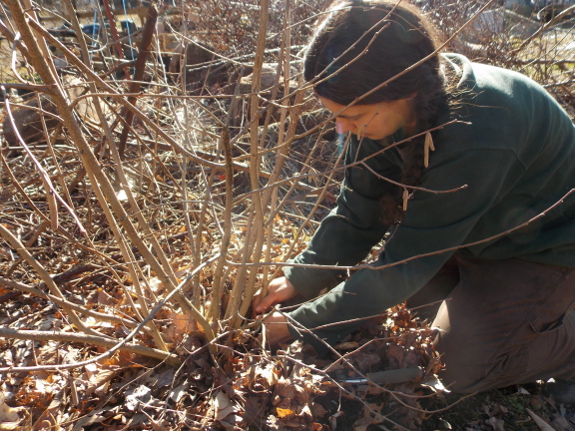
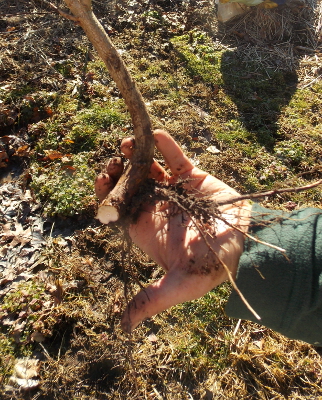 On
a more pleasant note, the pruning afternoon turned into a bit of a
propagation spree as well. Our little hybrid hazel had sent up a
sucker that was far enough away from the parent plant that I could clip
it off and tease out some roots to go with it, and a gooseberry bush
also yielded up several kids. Kayla even found a rooted shoot at
the base of one of our hardy kiwis. I sent all of the babies home
with Kayla to hedge my bets --- if her plants thrive and mine fail, I
can always get cuttings from her to spruce back up our planting.
That seems like the permaculture way to create backups.
On
a more pleasant note, the pruning afternoon turned into a bit of a
propagation spree as well. Our little hybrid hazel had sent up a
sucker that was far enough away from the parent plant that I could clip
it off and tease out some roots to go with it, and a gooseberry bush
also yielded up several kids. Kayla even found a rooted shoot at
the base of one of our hardy kiwis. I sent all of the babies home
with Kayla to hedge my bets --- if her plants thrive and mine fail, I
can always get cuttings from her to spruce back up our planting.
That seems like the permaculture way to create backups.
Unless I've forgotten someone, every bush and tree in our homestead is
now pruned. Time to move on to the next project on my list!
Want more in-depth information? Browse through our books.
Or explore more posts by date or by subject.
About us: Anna Hess and Mark Hamilton spent over a decade living self-sufficiently in the mountains of Virginia before moving north to start over from scratch in the foothills of Ohio. They've experimented with permaculture, no-till gardening, trailersteading, home-based microbusinesses and much more, writing about their adventures in both blogs and books.
Want to be notified when new comments are posted on this page? Click on the RSS button after you add a comment to subscribe to the comment feed, or simply check the box beside "email replies to me" while writing your comment.

Anna, there was an article in my local paper that briefly mentioned "bridge grafts": "...gather prunings for use later as bark Band-Aids-- bridge grafts-- to repair the damage..." for vole damage. I had not heard of this before. http://www.mlive.com/news/kalamazoo/index.ssf/2014/02/winters_trouble_to_michigan_or.html#incart_river
It would be difficult to bridge graft with the tree being girdled that low.
You may want to consider inarch grafting. Below is the only youtube video I could find with a quick search.
http://www.youtube.com/watch?v=fnhaEfK-I5U
Below is a description that I found from a link you posted previously on your blog: http://www.ces.ncsu.edu/depts/hort/hil/grafting.html